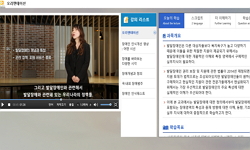배경 및 목적: 언어발달이 빠르게 이루어지는 시기에 복합적인 의사소통 요구(CCN)를가진 아동은 보완대체의사소통(AAC) 시스템을 사용하면 어린 나이부터 언어 및 의사소통에 대한 접근을 지...
http://chineseinput.net/에서 pinyin(병음)방식으로 중국어를 변환할 수 있습니다.
변환된 중국어를 복사하여 사용하시면 됩니다.
- 中文 을 입력하시려면 zhongwen을 입력하시고 space를누르시면됩니다.
- 北京 을 입력하시려면 beijing을 입력하시고 space를 누르시면 됩니다.

발달장애 초등학생의 AAC 상징 이해 정확도 및 선호도 = Comprehension and Preference of AAC Symbols in Elementary School Students with Developmental Disabilities
한글로보기https://www.riss.kr/link?id=A108405170
- 저자
- 발행기관
- 학술지명
- 권호사항
-
발행연도
2022
-
작성언어
Korean
-
주제어
보완대체의사소통 ; 그림 상징 ; 이해도 ; 선호도 ; 발달장애 ; AAC ; Graphic Symbol ; Comprehension of Symbol ; Preference of Symbol
-
등재정보
KCI등재
-
자료형태
학술저널
-
수록면
1-24(24쪽)
- 제공처
-
0
상세조회 -
0
다운로드
부가정보
국문 초록 (Abstract)
배경 및 목적: 언어발달이 빠르게 이루어지는 시기에 복합적인 의사소통 요구(CCN)를가진 아동은 보완대체의사소통(AAC) 시스템을 사용하면 어린 나이부터 언어 및 의사소통에 대한 접근을 지원할 수 있다. AAC에는 그림 상징이 많이 사용되는데 대부분의 상징들은 성인의 개념 이해에 기반해 제작되어 어린 아동이 상징을 이해하기 어려울 수있다. 이에 발달적으로 적절한 상징(DAS)이 개발되었고, 상징이해도와 선호도에 대한연구가 이루어졌는데 아직은 장애 아동에 대한 연구가 부족하다. 본 연구는 장애 아동을 대상으로 현재 국내에서 많이 사용되고 있는 한국형 AAC와 위톡(wetok)과 DAS의상징이해도와 선호도를 조사하고자 하였다. 방법: 연구대상자는 초등학교에 재학 중인발달장애아동 10명과 수용어휘를 일치시킨 일반아동 10명이다. 상징유형(DAS, 한국형AAC, 위톡)에 따라 7개 어휘(먹다, 오다, 크다, 없다, 누구, 무엇, 위)를 설명한 후, 상징이해 정확도와 선호도 검사를 실시하여 집단 간 차이를 알아보았다. 결과: 일반아동이장애아동에 비해 상징 이해도 점수가 높았고, 발달장애 집단에서는 한국형 AAC가, 일반집단에서는 DAS가 높은 이해정확도를 나타냈다. 상징 선호도에서는 발달장애집단은 DAS, 일반집단은 위톡을 가장 많이 선호하는 것으로 나타났다. 논의 및 결론: 본 연구를 통해장애 아동의 상징 이해도와 선호도가 일반 아동과 다르다는 것을 확인하였다. 이는 AAC 상징 개발 시 사용자의 특성을 고려하여 상징이 개발되고 선택되어야 함을 시사한다.
1 최정은 ; 한경임, "그림 상징체계에 대한 유아들의 도상성 인식 조사" 한국지체.중복.건강장애교육학회 58 (58): 217-247, 2015
2 나지영 ; 이수향 ; 오경아 ; 이진희, "Visual Attention Patterns on PCS Emotion Symbols in American and Korean College Students: An Eye-Tracking Study" The Korean Society for Augmentative and Alternative Communication 7 (7): 75-93, 2019
3 연석정 ; 김영태 ; 박은혜, "Transparency and Name Agreement of Korean Ewha-AAC symbols - Nouns, Verbs, and Adjectives -" The Korean Society for Augmentative and Alternative Communication 4 (4): 45-, 2016
4 Branson, D., "The use of augmentative and alternative communication methods with infants and toddlers with disabilities : A research review" 25 (25): 274-286, 2009
5 Callaghan, T. C., "The origins and development of pictorial symbol functioning, Children’s understanding and production of pictures" 21-30, 2008
6 Worah, S., "The effect of redesigning the representations of early emerging concepts of identification and preference: A comparison of two approaches for representing vocabulary in augmentative and alternative communication (AAC) systems for young children" Pennsylvania State University 2008
7 Kim, Y. X., "Receptive & Expressive Vocabulary Test(REVT)" Community Rehabilitation Center 2009
8 Light, J., "Graphic representations of early emerging language concepts by young children from different cultural backgrounds: Implications for AAC symbols"
9 이효주 ; 박현주, "Conceptual Understanding and Preference of Preschool-Aged Children According to Type of Graphic Symbols" The Korean Society for Augmentative and Alternative Communication 4 (4): 65-, 2016
10 최현주 ; 박현주, "Comprehension and Preference of Graphic Symbols in School-Age Children" The Korean Society for Augmentative and Alternative Communication 7 (7): 29-49, 2019
1 최정은 ; 한경임, "그림 상징체계에 대한 유아들의 도상성 인식 조사" 한국지체.중복.건강장애교육학회 58 (58): 217-247, 2015
2 나지영 ; 이수향 ; 오경아 ; 이진희, "Visual Attention Patterns on PCS Emotion Symbols in American and Korean College Students: An Eye-Tracking Study" The Korean Society for Augmentative and Alternative Communication 7 (7): 75-93, 2019
3 연석정 ; 김영태 ; 박은혜, "Transparency and Name Agreement of Korean Ewha-AAC symbols - Nouns, Verbs, and Adjectives -" The Korean Society for Augmentative and Alternative Communication 4 (4): 45-, 2016
4 Branson, D., "The use of augmentative and alternative communication methods with infants and toddlers with disabilities : A research review" 25 (25): 274-286, 2009
5 Callaghan, T. C., "The origins and development of pictorial symbol functioning, Children’s understanding and production of pictures" 21-30, 2008
6 Worah, S., "The effect of redesigning the representations of early emerging concepts of identification and preference: A comparison of two approaches for representing vocabulary in augmentative and alternative communication (AAC) systems for young children" Pennsylvania State University 2008
7 Kim, Y. X., "Receptive & Expressive Vocabulary Test(REVT)" Community Rehabilitation Center 2009
8 Light, J., "Graphic representations of early emerging language concepts by young children from different cultural backgrounds: Implications for AAC symbols"
9 이효주 ; 박현주, "Conceptual Understanding and Preference of Preschool-Aged Children According to Type of Graphic Symbols" The Korean Society for Augmentative and Alternative Communication 4 (4): 65-, 2016
10 최현주 ; 박현주, "Comprehension and Preference of Graphic Symbols in School-Age Children" The Korean Society for Augmentative and Alternative Communication 7 (7): 29-49, 2019
11 Beukelman, D. R., "Augmentative and alternative communication:supporting children and adults with complex communication needs" Paul H. Brookes Publishing Co 2005
12 "American Speech-Language-Hearing Association"
13 Light, J., "AAC interventions to maximize language development for you children"
14 Worah, S., "A comparison of two approaches for representiong AAC vocabulary for young children" 17 (17): 460-469, 2015
15 신상은 ; 김영태 ; 박은혜, "A Study on the Verification of AAC Graphic Symbols Focusing on Nouns, Adverbs, and Verbs" Korean Academy of Speech-Language Pathology and Audiology 22 (22): 597-607, 2017
16 권회연 ; 김미선, "A Review Regarding Iconicity of Graphic Symbol Systems for Augmentative and Alternative Communication" The Korean Association on Intellectual Disabilities 21 (21): 97-116, 2019
17 권회연 ; 박성지, "A Characteristics of Picture Symbolic Expression of Four-year-old Infants" 한국특수아동학회 21 (21): 141-161, 2019
18 한경임 ; 최정은, "3세와 5세 유아의 보완대체 의사소통 그림상징체계에 대한 도상성 인식 차이" 한국지체.중복.건강장애교육학회 59 (59): 79-107, 2016
동일학술지(권/호) 다른 논문
-
전의도적 의사소통 단계의 뇌성마비 자녀의 의사소통 발달을 위한 AAC 부모교육 효과
- 한국보완대체의사소통학회
- 고희선
- 2022
- KCI등재
-
관점 유형에 따른 일반아동의 그래픽 상징 인식 및 선호도
- 한국보완대체의사소통학회
- 김규리
- 2022
- KCI등재
-
손담을 활용한 의사소통 중재가 시각중복장애 학생의 의사소통 반응 행동에 미치는 영향
- 한국보완대체의사소통학회
- 이은주
- 2022
- KCI등재
-
- 한국보완대체의사소통학회
- 정사영
- 2022
- KCI등재





 KCI
KCI







